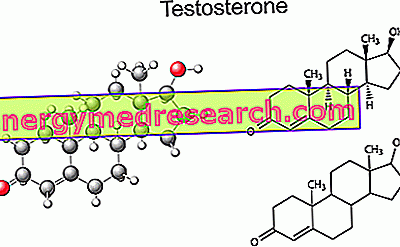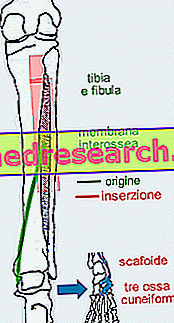Pemphigus in summary
Pemphigus is a rare disease with autoimmune pathogenesis that affects the skin and / or mucous membranes. The disease is characterized by the production of autoantibodies (IgG or, in rare cases, IgA) that damage the molecules responsible for maintaining cohesion between the epithelial cells of the body (desmogleins).

Any area of the body can be affected. In some forms, pemphigus is located mainly in the mouth and throat. The elementary lesions of the disease are flaccid intraepidermal blisters, containing serous fluid and varying in size. These formations can break and go to the erosion phase with scabs. The lesions tend to become chronic for a variable period, before real ulcers appear on the skin. Often, the latter face infections. The bubbles, which occur in the oral cavity or in the upper part of the esophagus, can aggravate the patient's general condition, making regular feeding almost impossible and inducing a gradual physical decay. The causes that induce this dermatosis are numerous and multifactorial. Pemphigus does not appear to respect an inherited transmission, but the expression of some genes may make it more susceptible to the onset of dermatosis. Prevention is not possible to prevent the disease, but in most cases, it appears in middle-aged or elderly subjects, while it is rare in children. Furthermore, it is useful to remember that this autoimmune form of bullous dermatosis is not contagious (it is not transmitted from person to person). Pemphigus can be potentially fatal, due to several complications that may arise during the course, such as secondary skin infections or sepsis. To obtain diagnostic confirmation of pemphigus, it is necessary to subject the patient to the biopsy of a recent lesion and of the neighboring skin (histological analysis to characterize the? Acantholysis), perform a cytodiagnostic examination (Tzanck test) and search for the Nikolsky sign, which must be positive. Also the search for circulating or tissue autoantibodies, by immunofluorescence, is useful for the diagnosis and allows the distinction with other pathologies, while their monitoring over time can help to follow the course of the pemphigus.
Pemphigus is a disease often associated with a fairly serious prognosis, and one that responds unpredictably to treatment. Sometimes this condition, if treated rationally, allows survival for a prolonged time and, in some cases, recovery. The therapy aims to reduce the clinical signs and symptoms of pemphigus, and to prevent complications; it may include local measures, general medications and, sometimes, hospitalization.
Therapeutic treatment of pemphigus is generally more effective if it starts early. Following the therapy, the evolution of the disease is variable: some patients have a positive prognosis, while others must continue to take low-dose drugs for an indefinite period, in order to avoid relapses or recurrences.
Secondary Complications
Without treatment, pemphigus is usually lethal: generalized infection is the most frequent cause of death. With treatment, the disorder tends to become chronic in most cases.
Possible complications of pemphigus include:
- Secondary skin infections;
- Sepsis, if the infection spreads through the bloodstream;
- Severe dehydration;
- Drug side effects, which can be serious or disabling;
- Death, in rare cases, if serious infections are needed.
The patient should consult his doctor if persistent lesions appear (over 7 days), which cannot be associated with explainable conditions; they are warning signs: bubbles on apparently healthy skin, unexplained crusts and chronic ulceration of the mucous membranes.
If pemphigus has already been diagnosed and a therapeutic regimen is in progress, it is advisable to consult your doctor if one of the following clinical signs develops:
- Occurrence of new blisters or ulcers (due to broken lesions);
- A rapid spread of the number of erosive lesions;
- Temperature;
- Chills;
- Muscular or joint pains.
Treatment
Pharmacological treatment
The main goal of the treatment is to reduce the formation of bubbles, prevent infections and promote the healing of lesions and erosions. Sometimes, mild cases of pemphigus respond to the effect of topical steroids. The most common systemic treatment mainly includes the administration of steroid cortisone derivatives by mouth (in particular prednisone), often in high doses.
The interpretation of the autoimmune etiology of pemphigus induced the effective association of corticosteroids with immunosuppressive drugs. The immunosuppression, mediated by azathioprine or cyclophosphamide, allows a better management of the condition, as it allows to obtain the same therapeutic results with lower dosages of corticosteroids. However, it is necessary to remember that the side effects of a systemic treatment are an important complication, and that for this the patient must be carefully monitored by the doctors.
Once pemphigus outbreaks are under control, drug dosage is often reduced. If the patient, after a year of therapeutic regimen, does not incur his condition worsening, it is possible to make an attempt to suspend treatment and keep the patient under strict medical supervision.
Systemic treatment
Oral corticosteroids (example: prednisone): these drugs represent the medical treatment of choice, for the control of the disease. Following their introduction into the therapeutic protocol, the prognosis of pemphigus has been revolutionized and the mortality rate has recorded a significant decrease (from 99% to about 5-15% of cases). Corticosteroids do not constitute a cure for the disease, but improve the patient's quality of life by reducing inflammation (redness and pain) and disease activity. The symptoms of pemphigus can begin to improve within a few days: the formation of new bullous lesions can stop within 2-3 weeks, while the old ones heal in 6-8 weeks. The therapeutic protocol may initially include intravenous administration of a high dose of corticosteroids and subsequent stabilization with oral intake and progressive dose reduction. The minimum daily dose should be subjectively identified and should be sufficient to prevent pemphigus activity (the formation of new blisters) and control the symptoms. The therapy lasts 6-12 months. However, the use of corticosteroids for a prolonged time or in high doses can cause serious side effects (Cushing's syndrome), including: increased blood glucose levels, osteoporosis, increased risk of infection, water retention, cataract, glaucoma etc.
Other drugs for pemphigus therapy can be used alone or in combination and help minimize steroid use. These commonly prescribed drugs include:
- Immunosuppressants. Drugs, such as methotrexate, cyclophosphamide, azathioprine, cyclosporin or mycophenolate mofetil, help suppress the immune system's reaction to healthy tissues (they act as cytostatic agents). The immunosuppressants can reduce the dosage of corticosteroids to be administered, therefore they are able to reduce the serious side effects due to this therapy in the long term; however they can make the patient more susceptible to infections.
- Antibiotics, antivirals and antifungal drugs. These can be prescribed to control or prevent secondary infections associated with the disease, particularly those caused by bacteria (eg staphylococci) or Herpes virus. An example is provided by treatment with tetracycline, doxycycline or minocycline . These systemic drugs also have a slightly beneficial effect on the disease, and are sometimes sufficient for the management of pemphigus foliaceus.
Topical treatments for skin and mouth
External therapy is of little importance and must be limited to:
- Cleansing and disinfection with antiseptic solutions of erosion areas, to promote localized healing.
- Application of topical corticosteroids carried by special formulations (sprays, creams, adhesive pastes ...).
Localized treatment of ulcers and boils can include:
- Hydrocolloid or silver sulfadiazine, for wound treatment, with the aim of preventing the appearance of new lesions and secondary infections;
- Mouthwashes containing an anesthetic, which can help reduce mild or moderate pain associated with ulcers in the oral mucosa;
- Lotions or creams that can relieve symptoms on the skin or to help dry the lesions;
- Wet dressings or similar measures for large areas of skin (example: saline compresses, antiseptic bandages with 3% sodium hypochlorite, etc.).
Alternative therapies
In cases of pemphigus refractory to conventional therapies or if serious adverse effects have already occurred, the doctor may propose the following alternatives:
- Periodic plasma apheresis: it consists in removing from the patient's plasma the IgG characteristic of the disease, through appropriate separation techniques. The plasma is then re-infused into the patient, after being supplemented with solutions of human albumin and gamma globulin. This leads to a reduction in the degree of auto-antibodies, with improvement of muco-cutaneous lesions. Plasmapheresis can be combined with an immunosuppressive drug. However, autoantibody suppression exposes the patient to greater risk of infection.
- Biological therapy with Rituximab: involves the administration of an anti-CD20 monoclonal antibody recently introduced in the treatment of pemphigus, called Rituximab. This selectively binds to B lymphocytes that potentially produce anti-desmoglein autoantibodies by triggering a series of reactions that lead to the lysis of the aforementioned cells.
- IVIg (intravenous immunoglobulin): induces a long-lasting reduction of anti-desmoglein autoantibody titers, with a parallel control of the disease's activity.
Hospitalization
If pemphigus does not affect an extended area of the body and is not too widespread, the patient can resort to home treatment. On the other hand, some more serious conditions may require hospitalization and protective isolation procedures: open wounds make the patient vulnerable to infections, which can be fatal if they spread to the bloodstream. The most severe cases of pemphigus are treated similarly to severe burns.
Hygienic-dietary standards
Patients must limit activities that can traumatize the skin and mucous membranes, during the active phases of the disease. Here are the steps to take to help with the management of pemphigus and to improve general health conditions:
- Minimize skin trauma. Avoid situations where the skin can be touched or hit, such as in contact sports.
- Ask your doctor for instructions for proper injury management. Taking care of wounds can help prevent infection and scarring.
- Use talc. Talcum powder is useful to prevent oozing and adhering to sheets and clothes.
- Avoid spicy or acidic foods. These foods can irritate or further damage the oral mucosa.
- Minimize sun exposure. Ultraviolet light can cause new bubbles to appear.
- Taking calcium and vitamin D supplements. Corticosteroid drugs used in the treatment of pemphigus can affect the intake of calcium and vitamin D, so you can contact your doctor to get advice on supplementing some additional nutrients.



